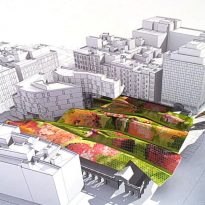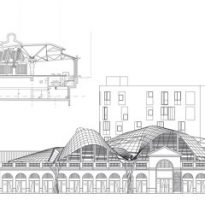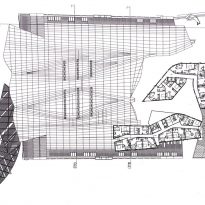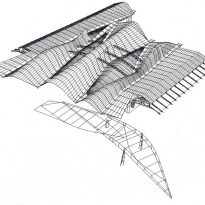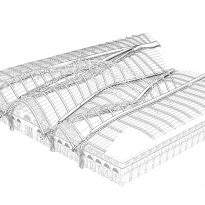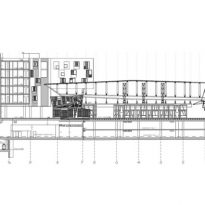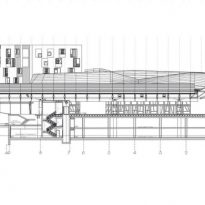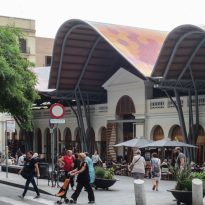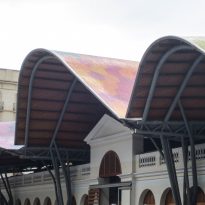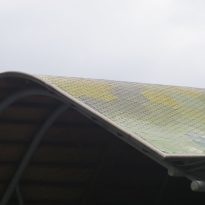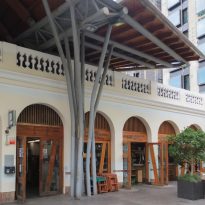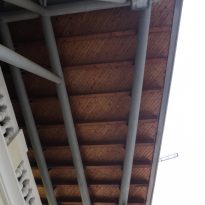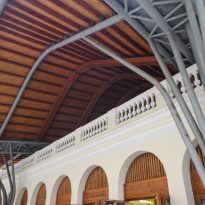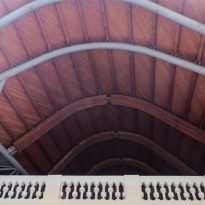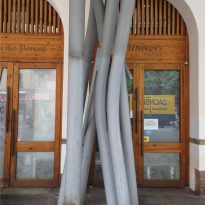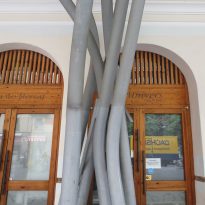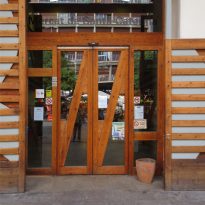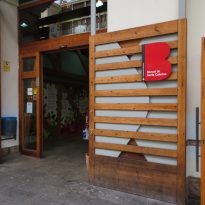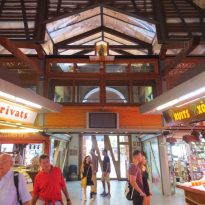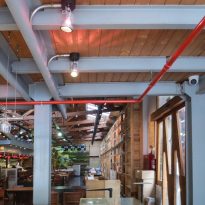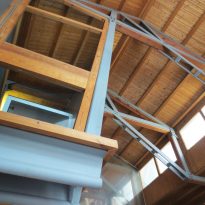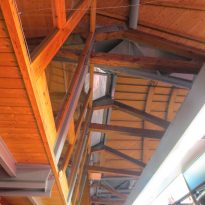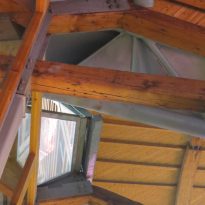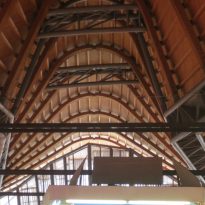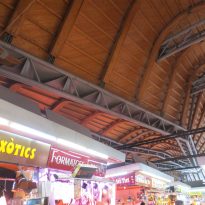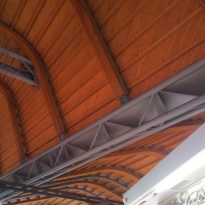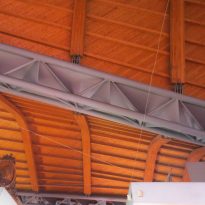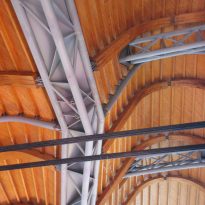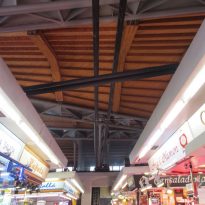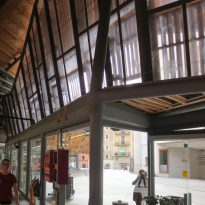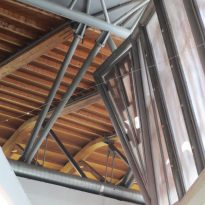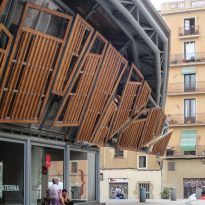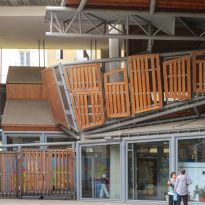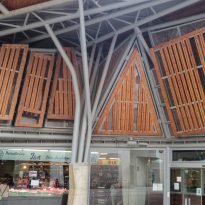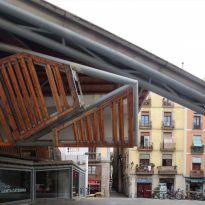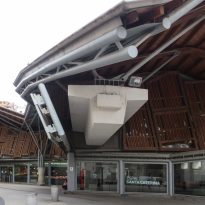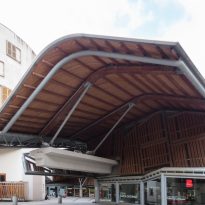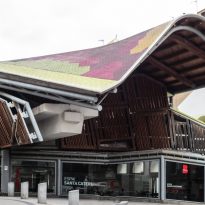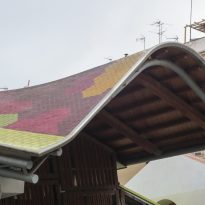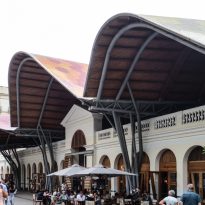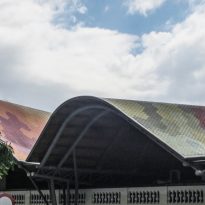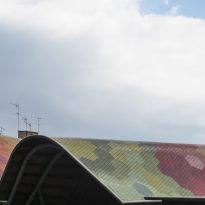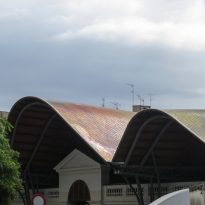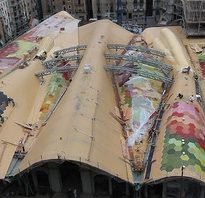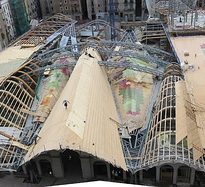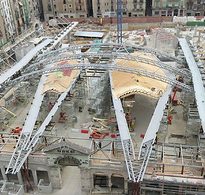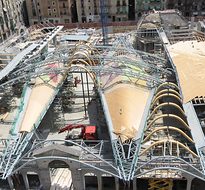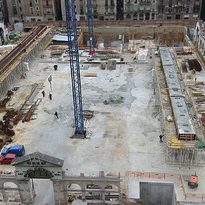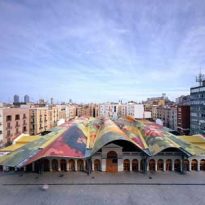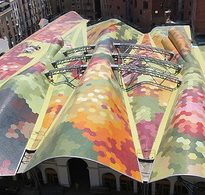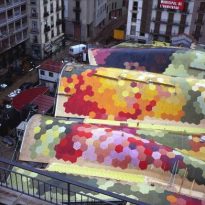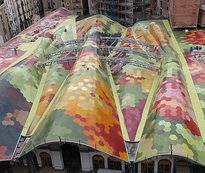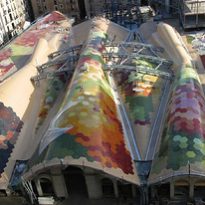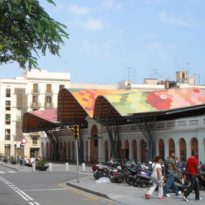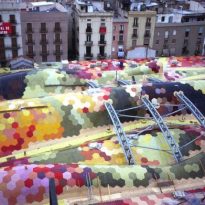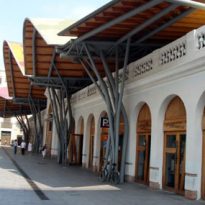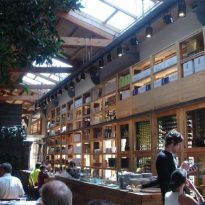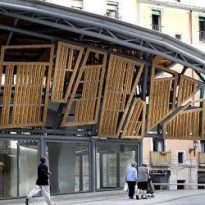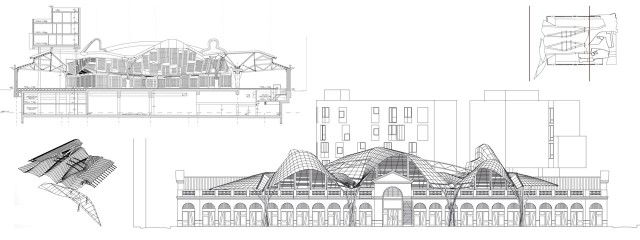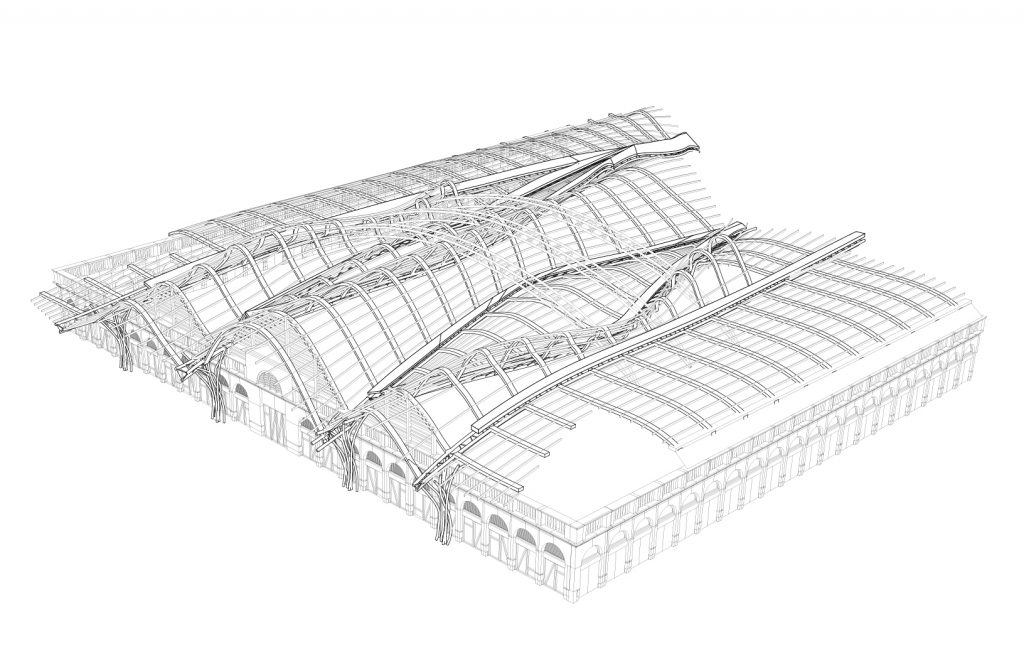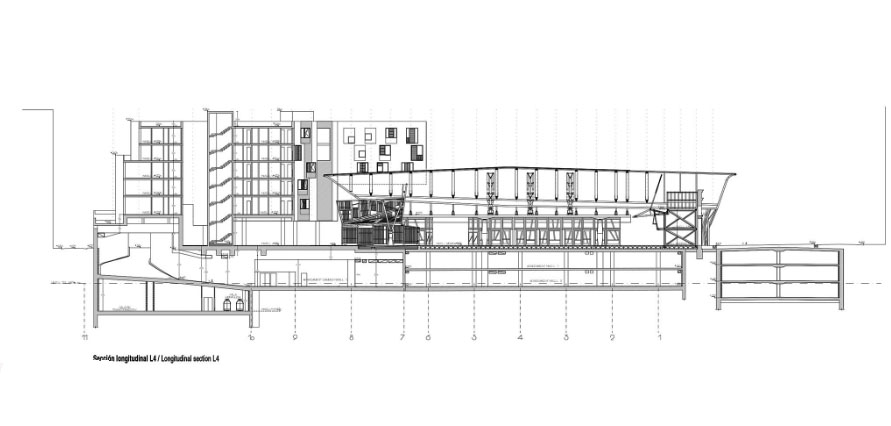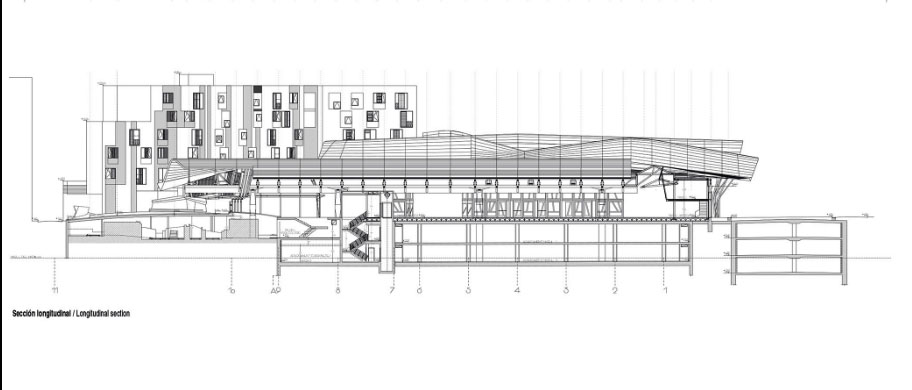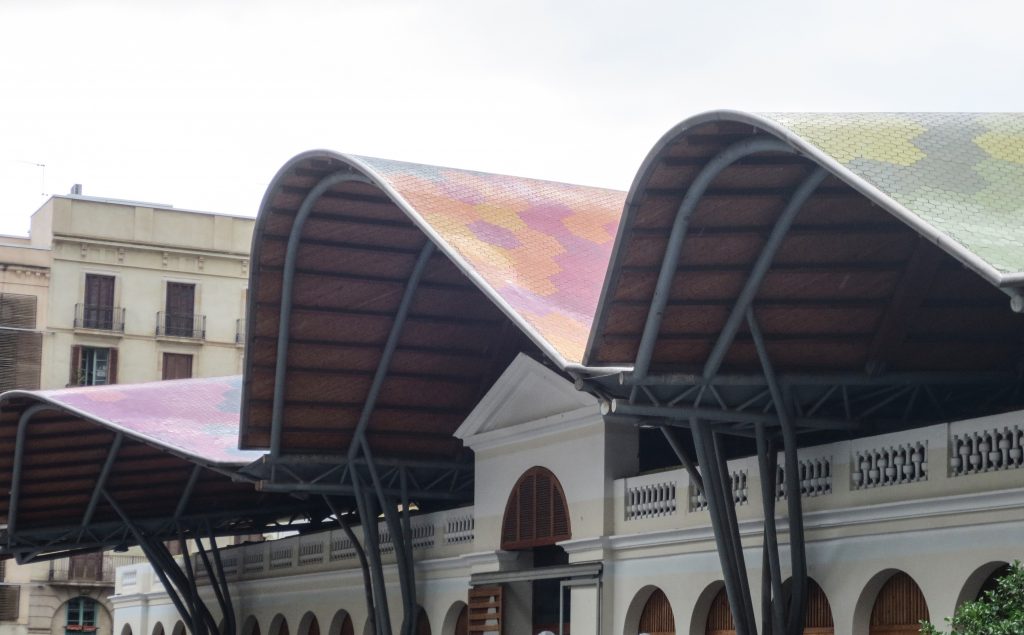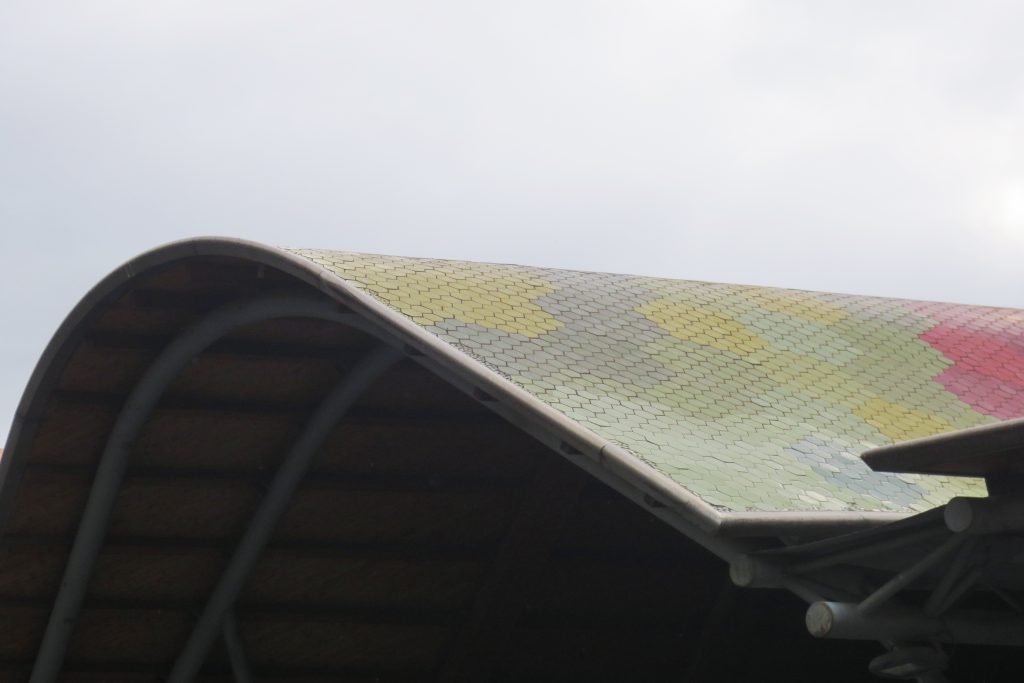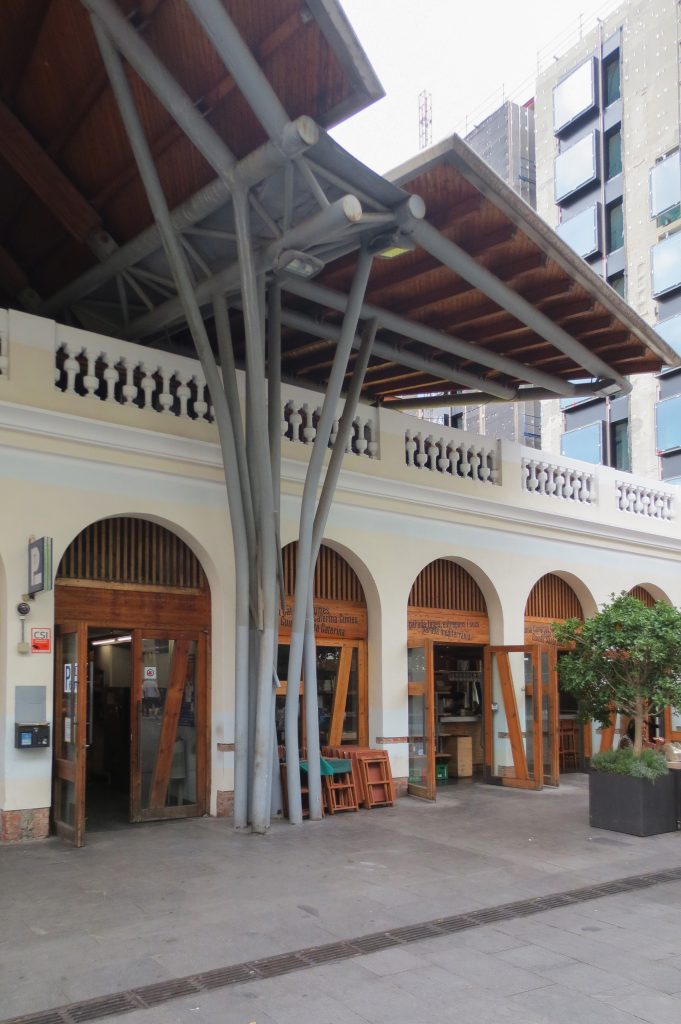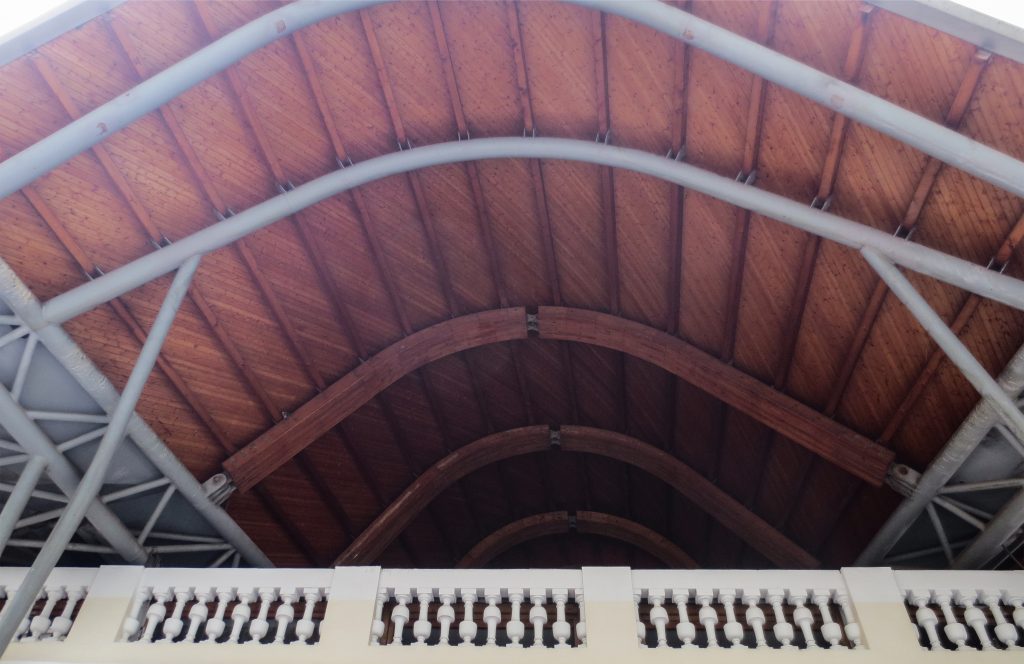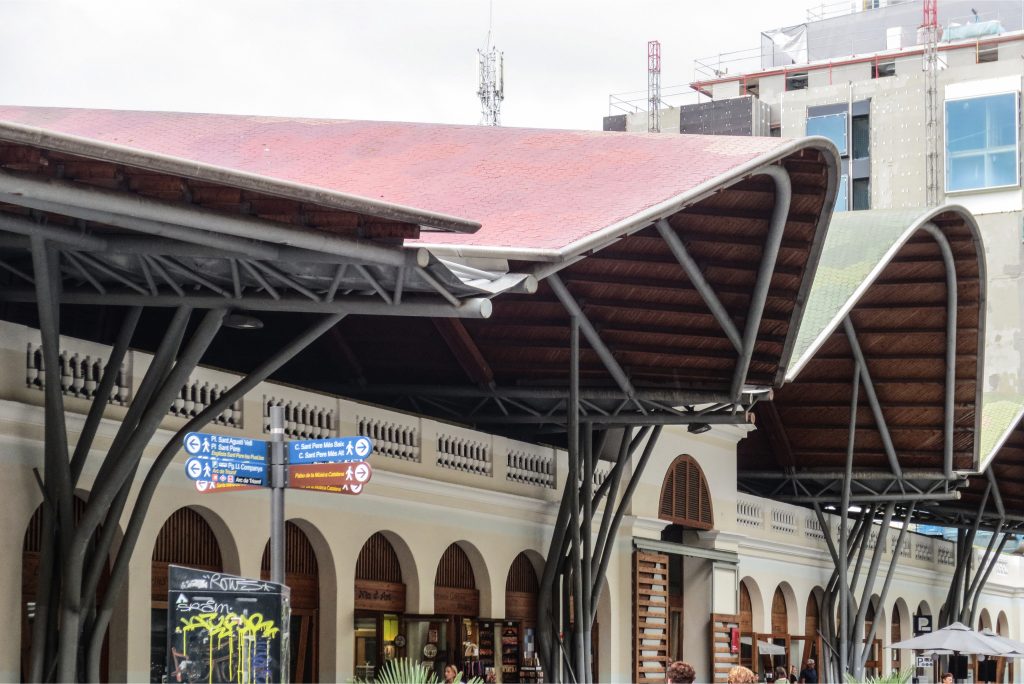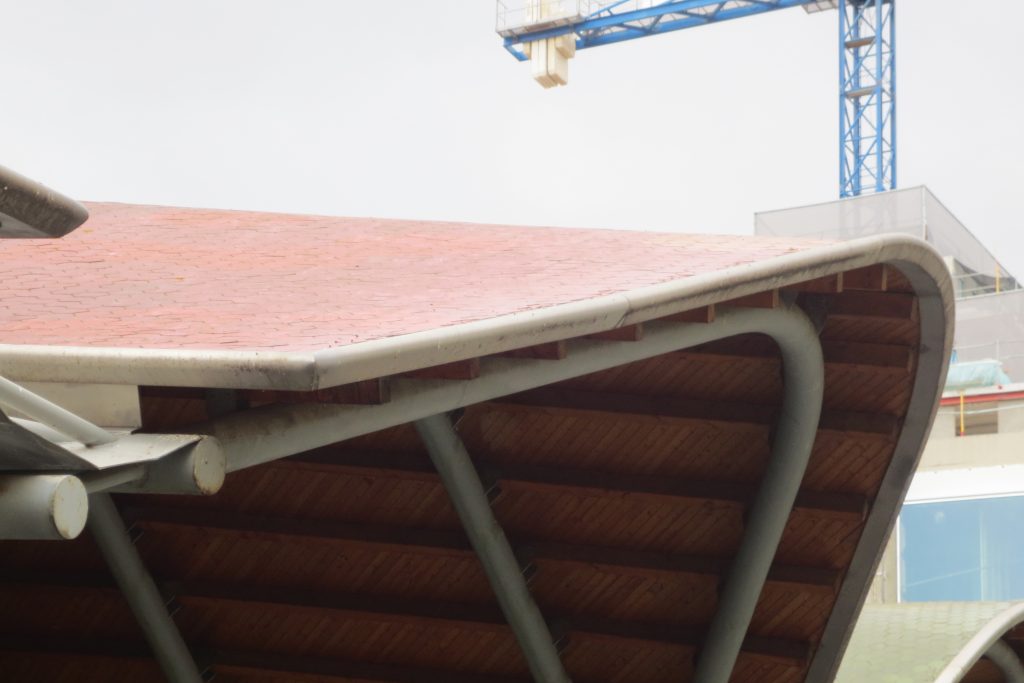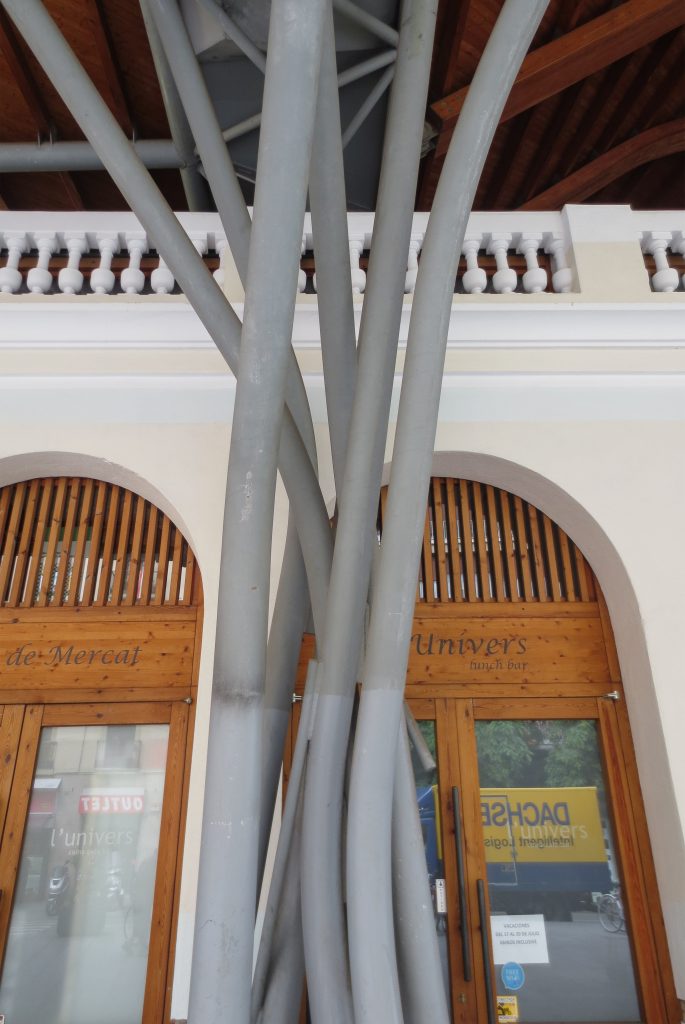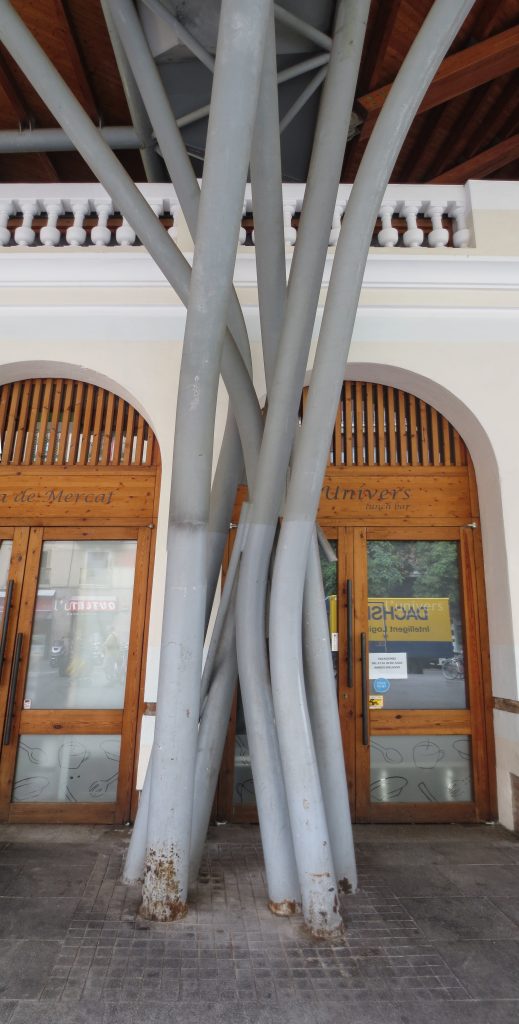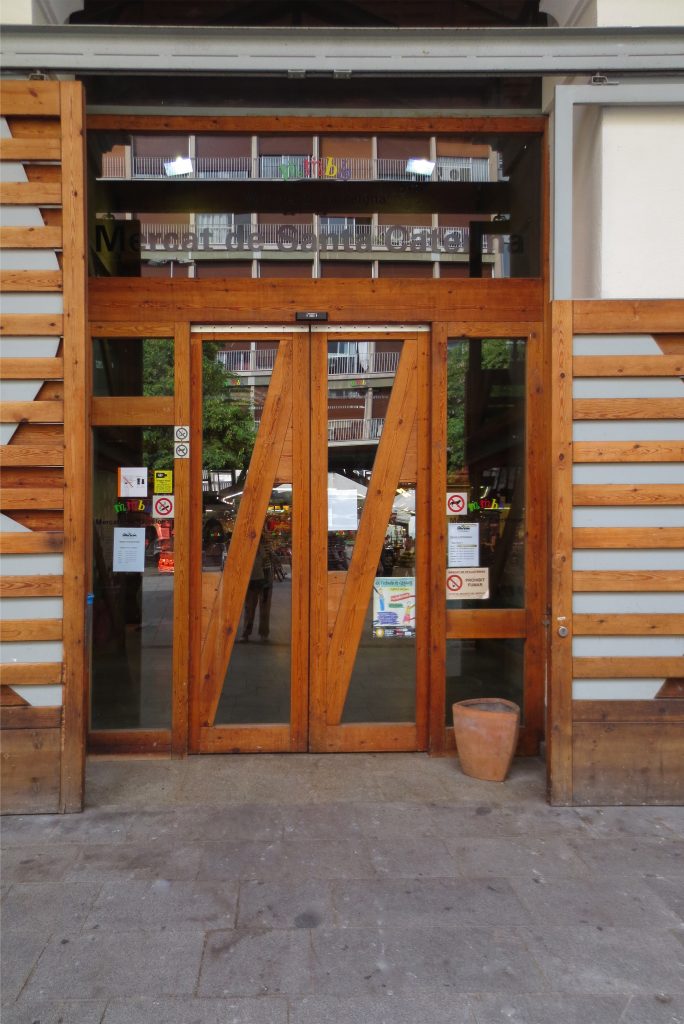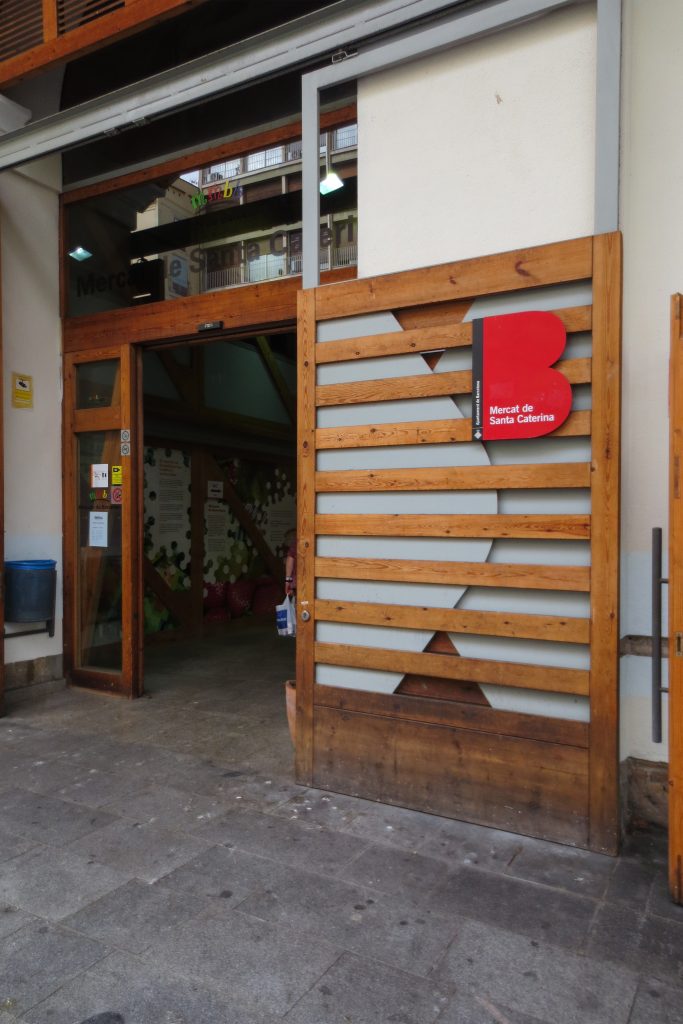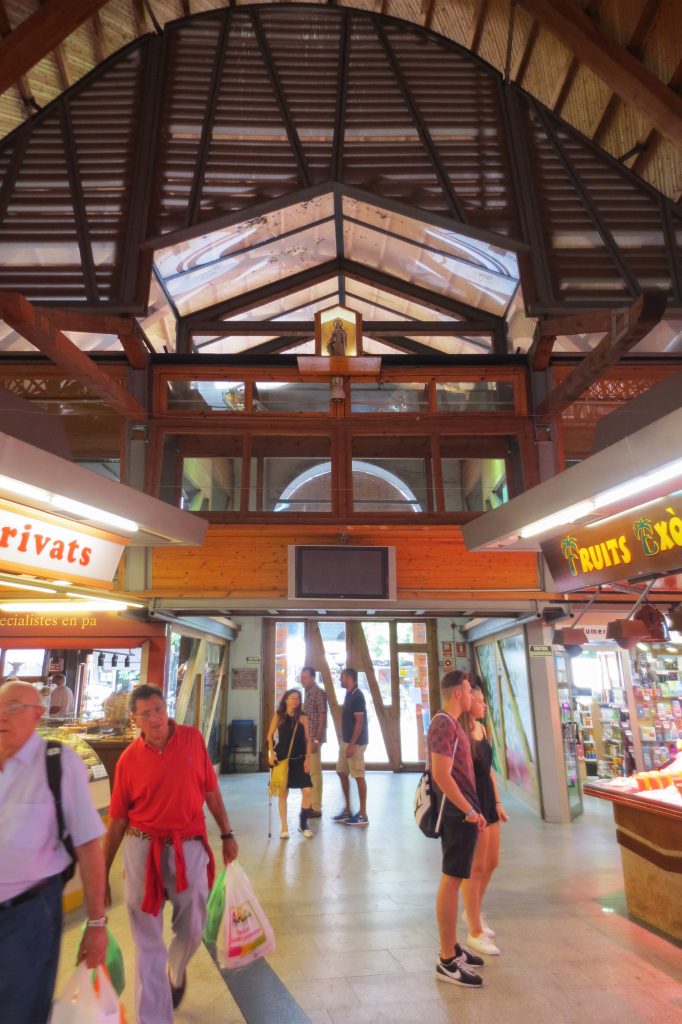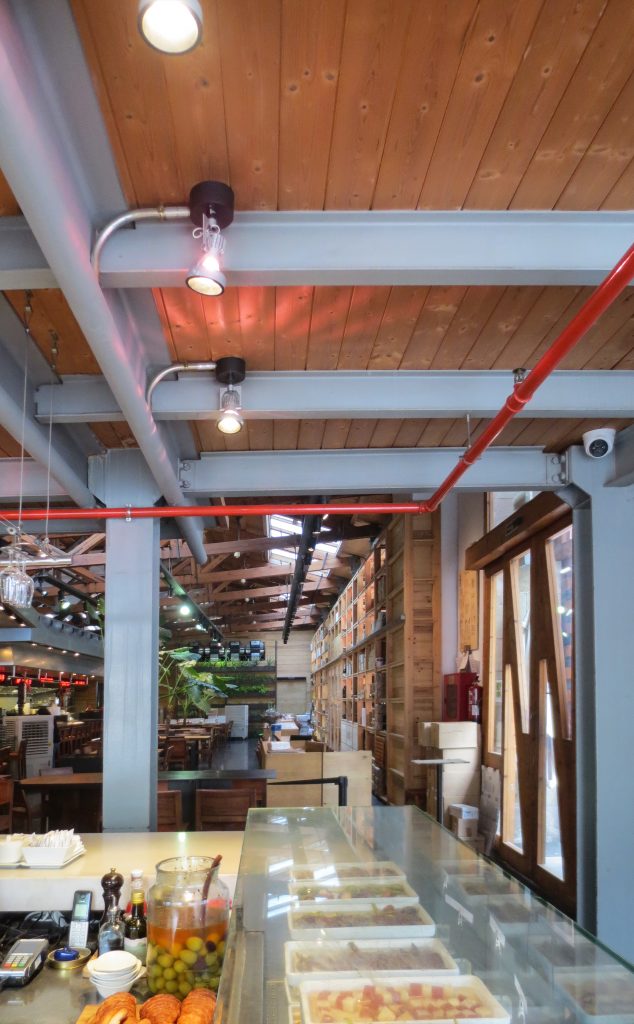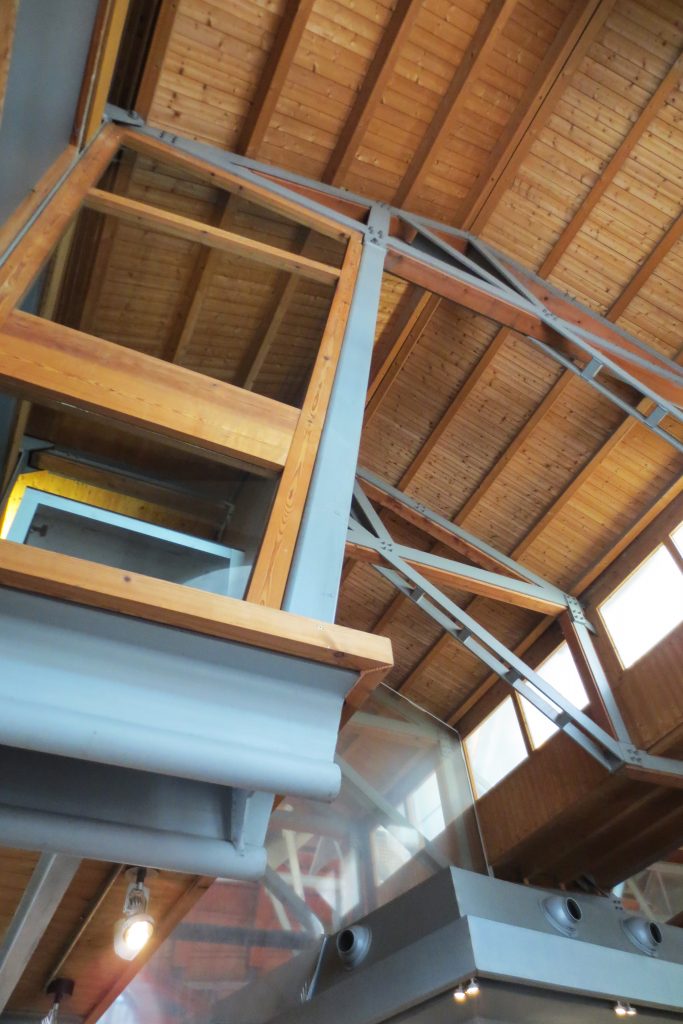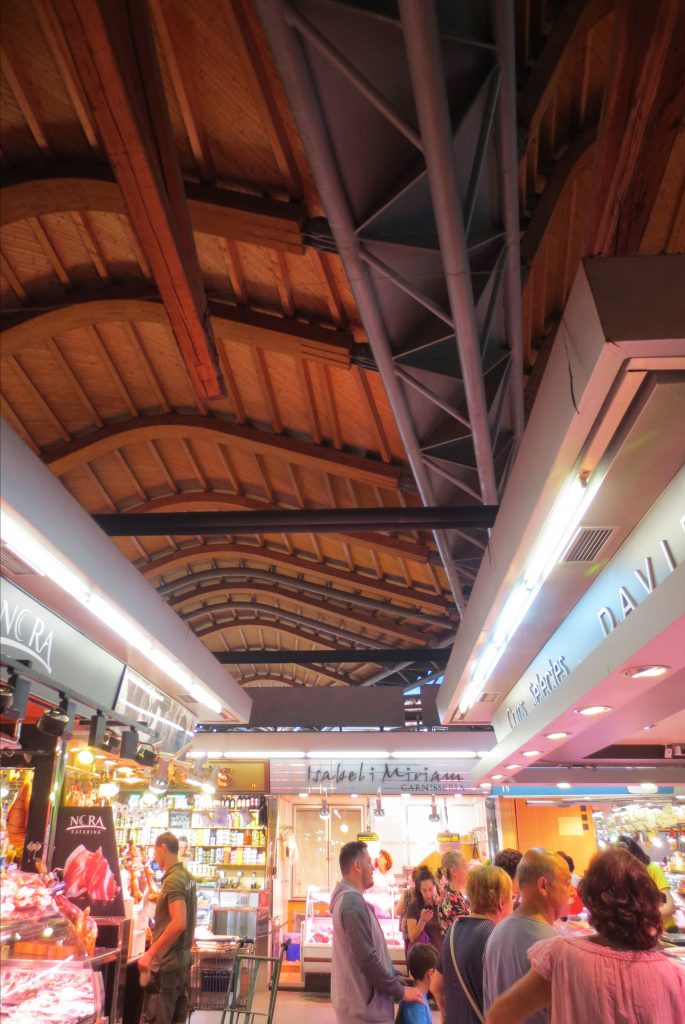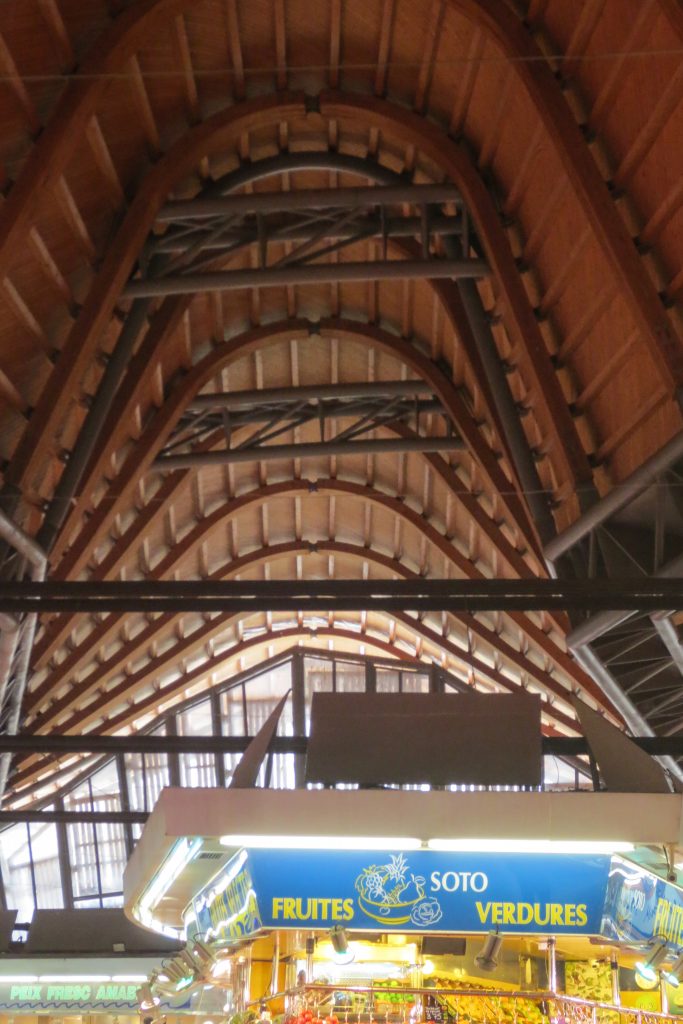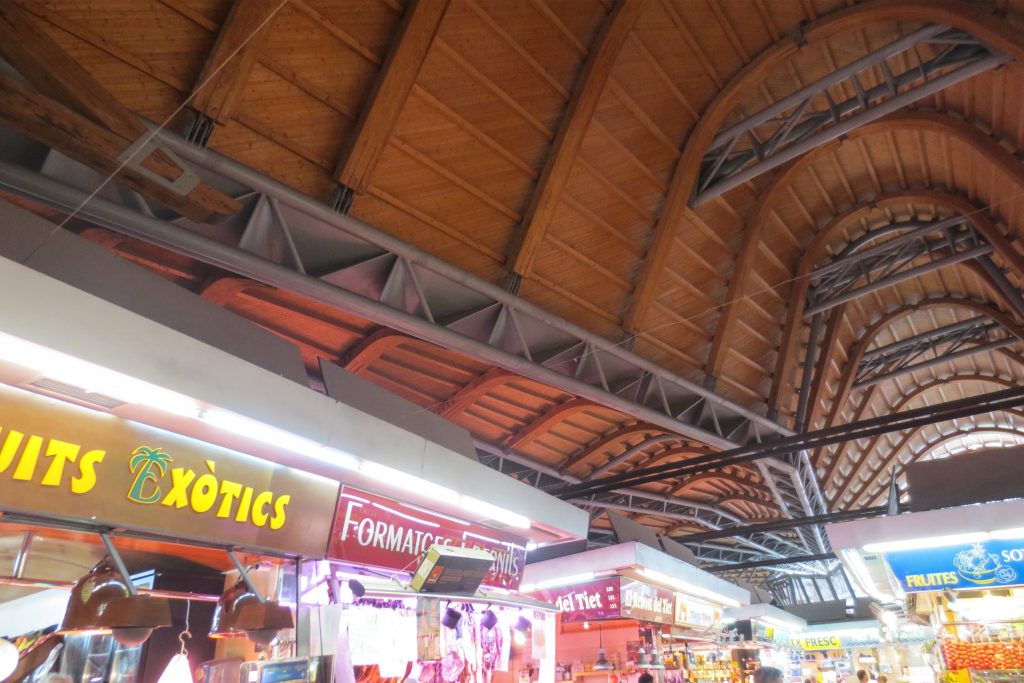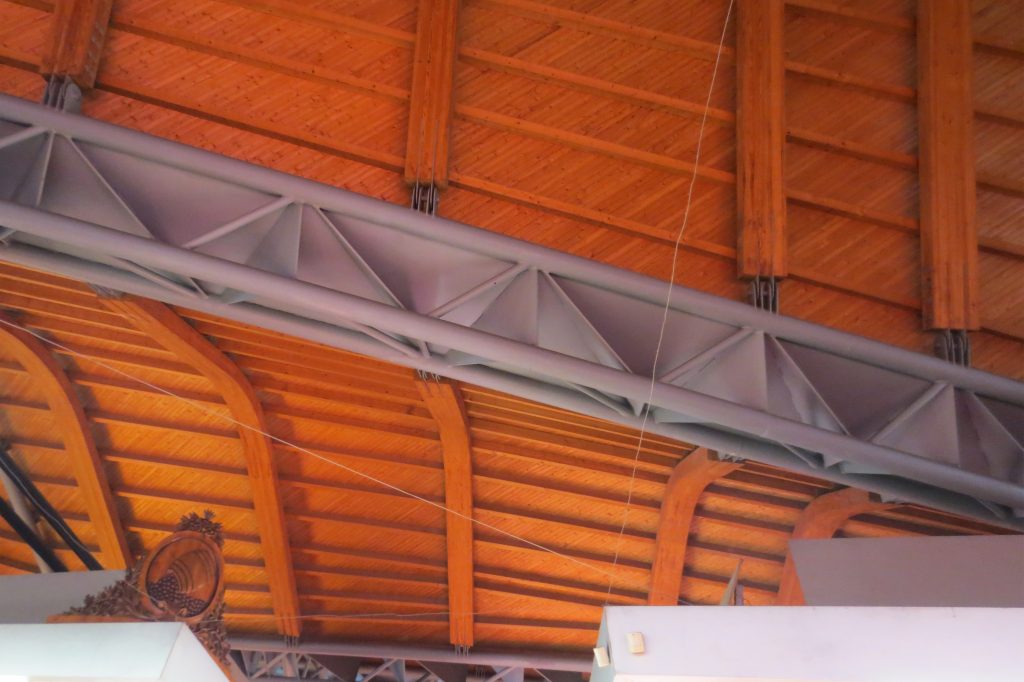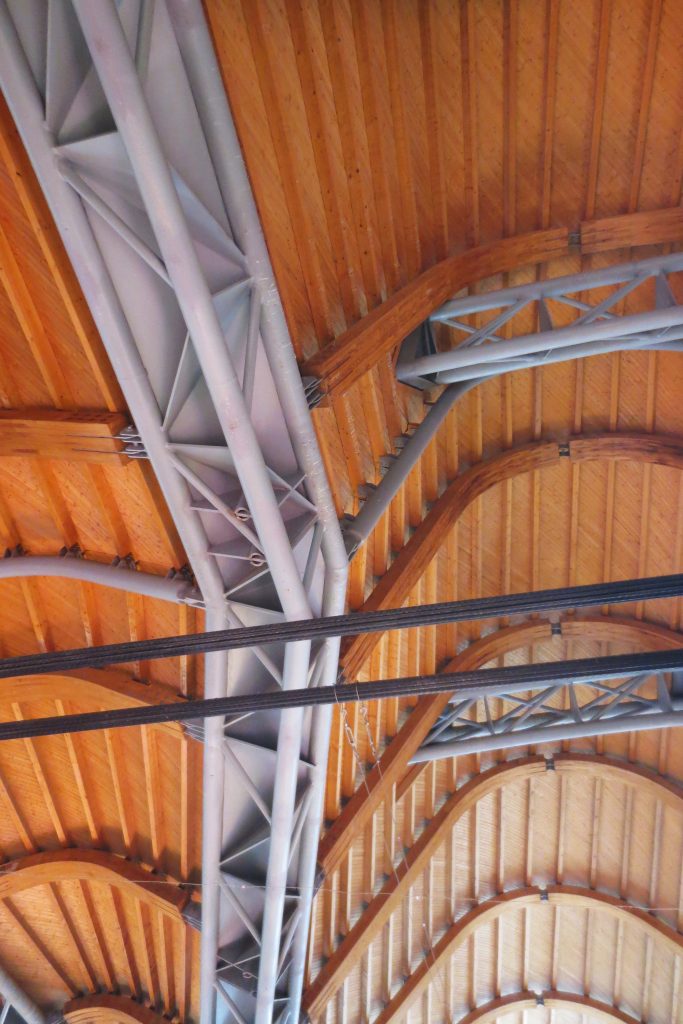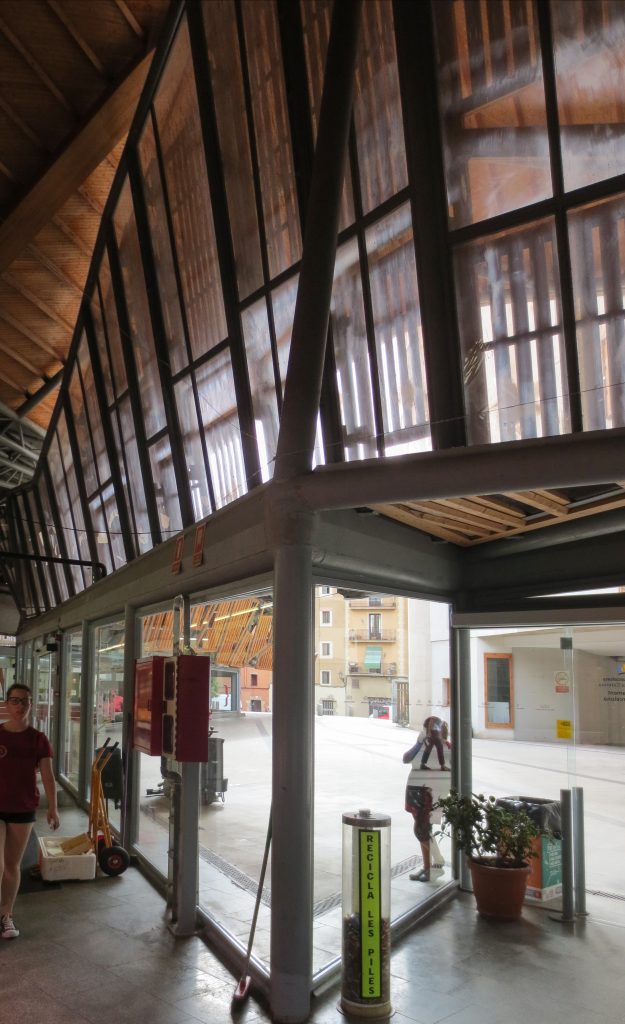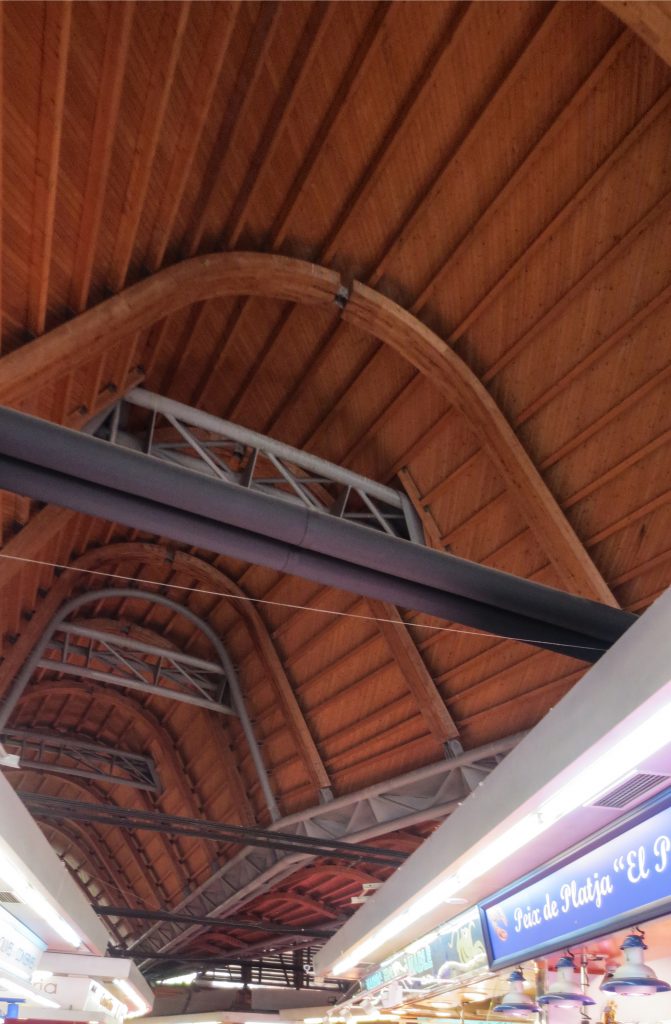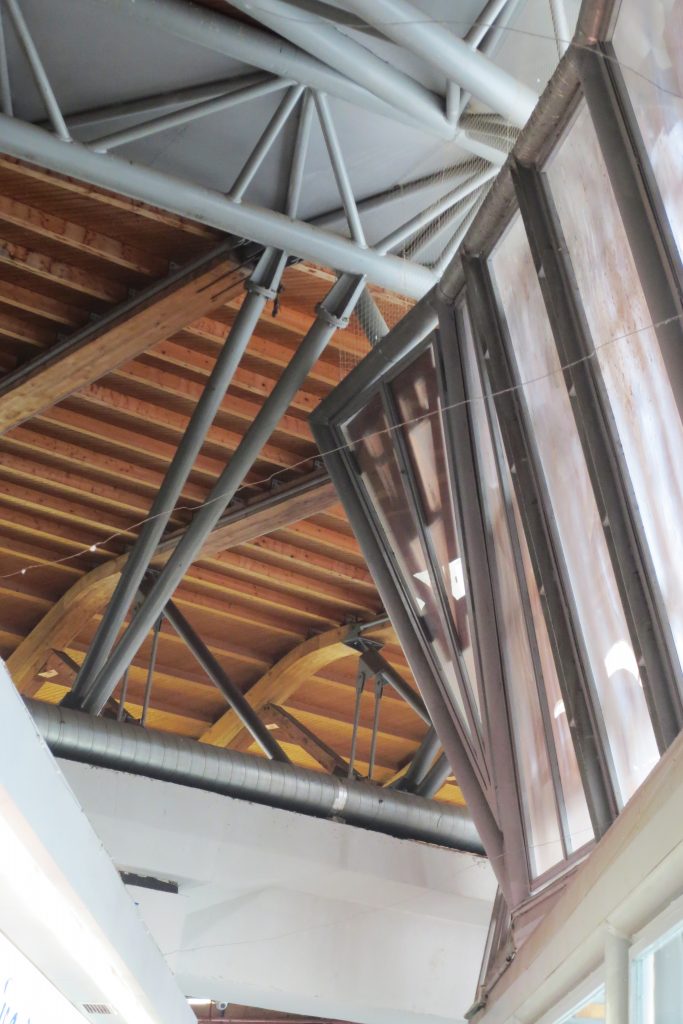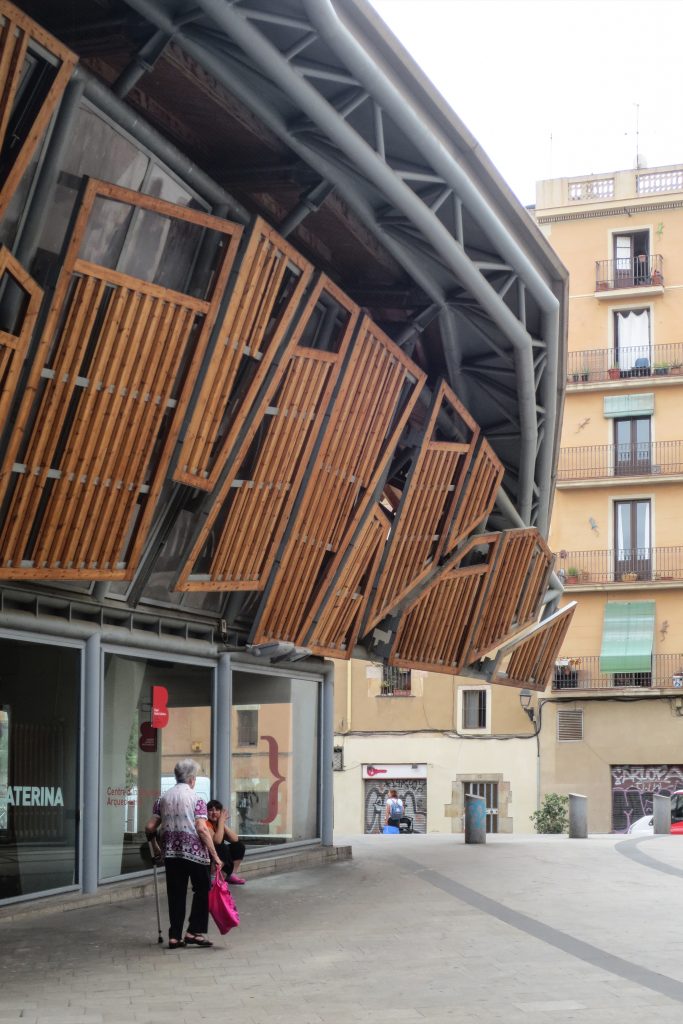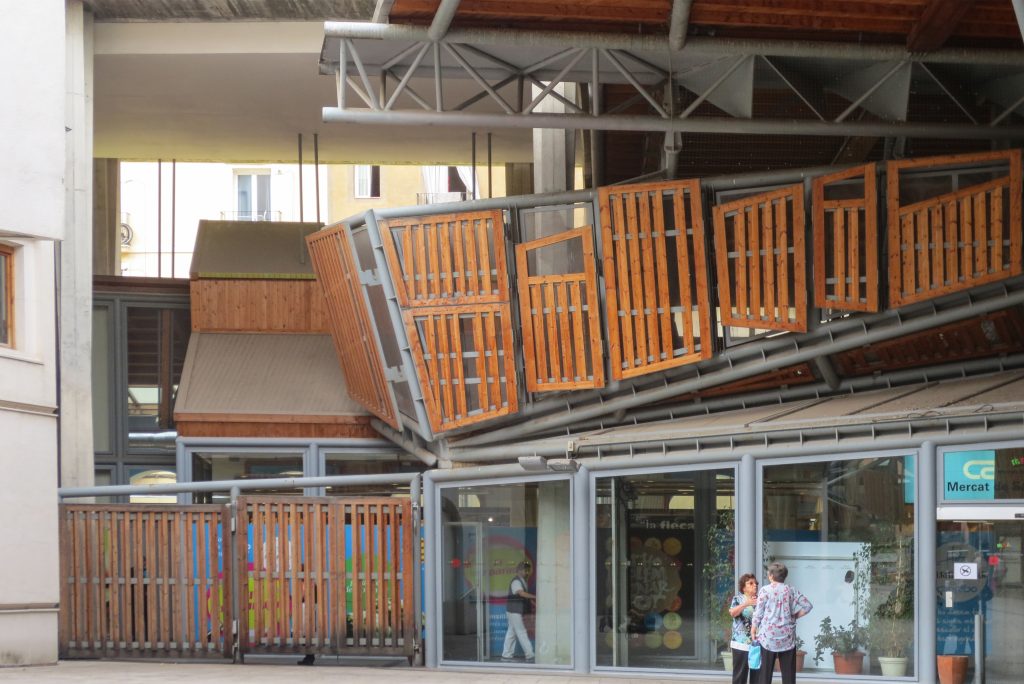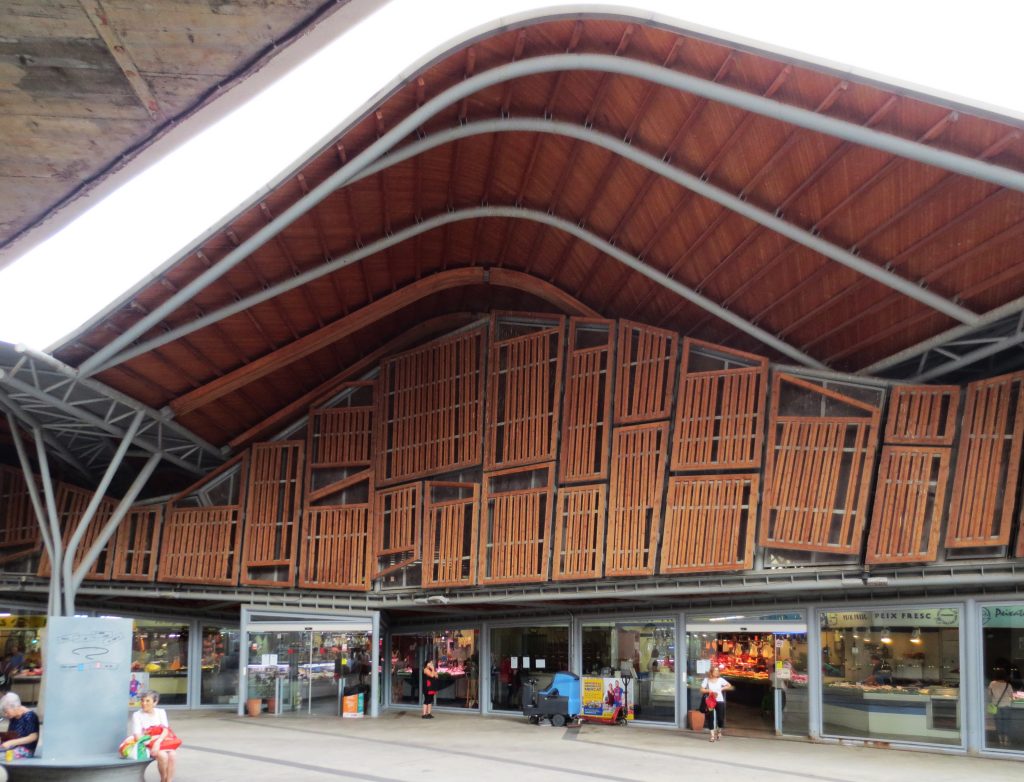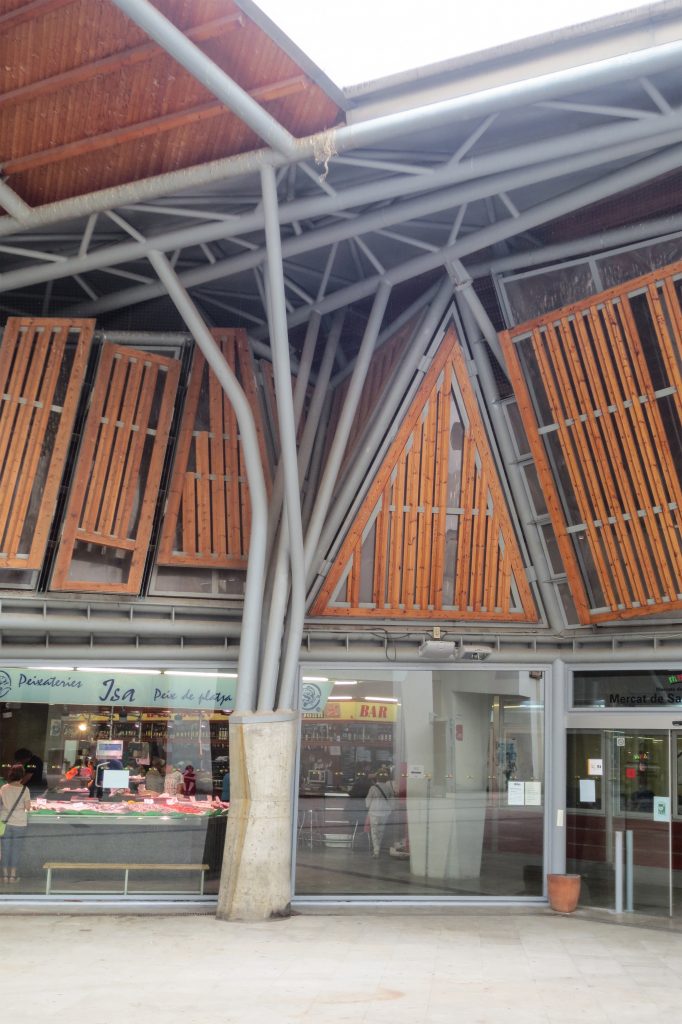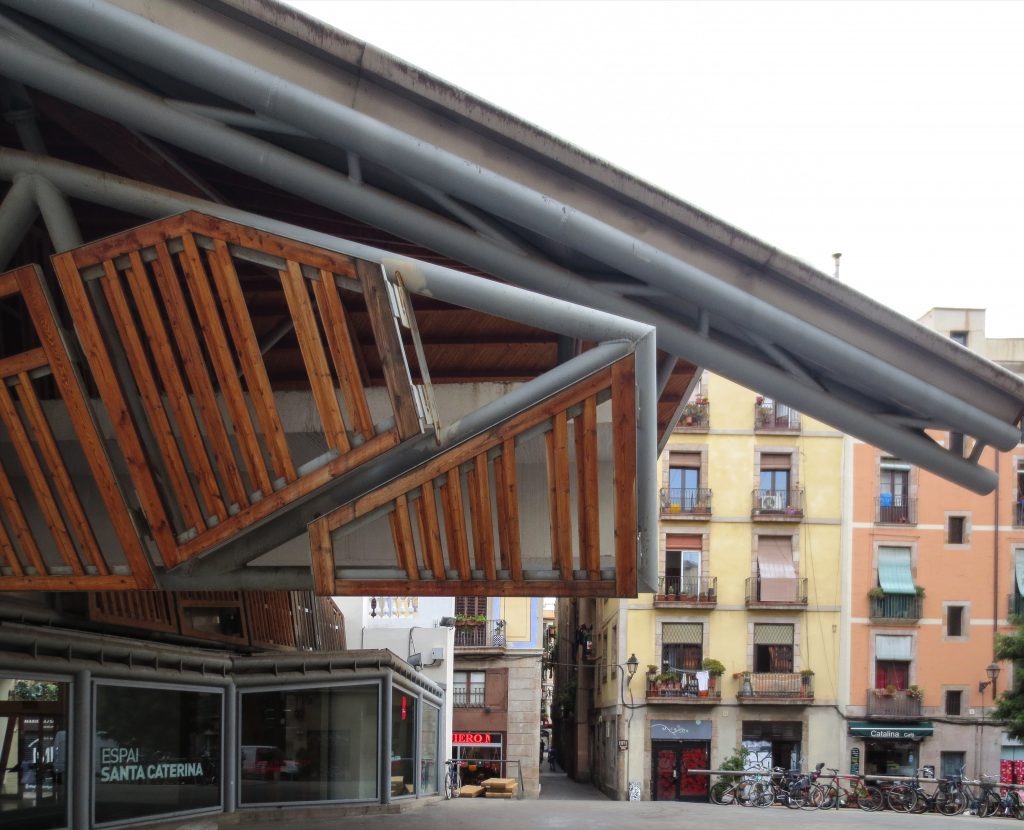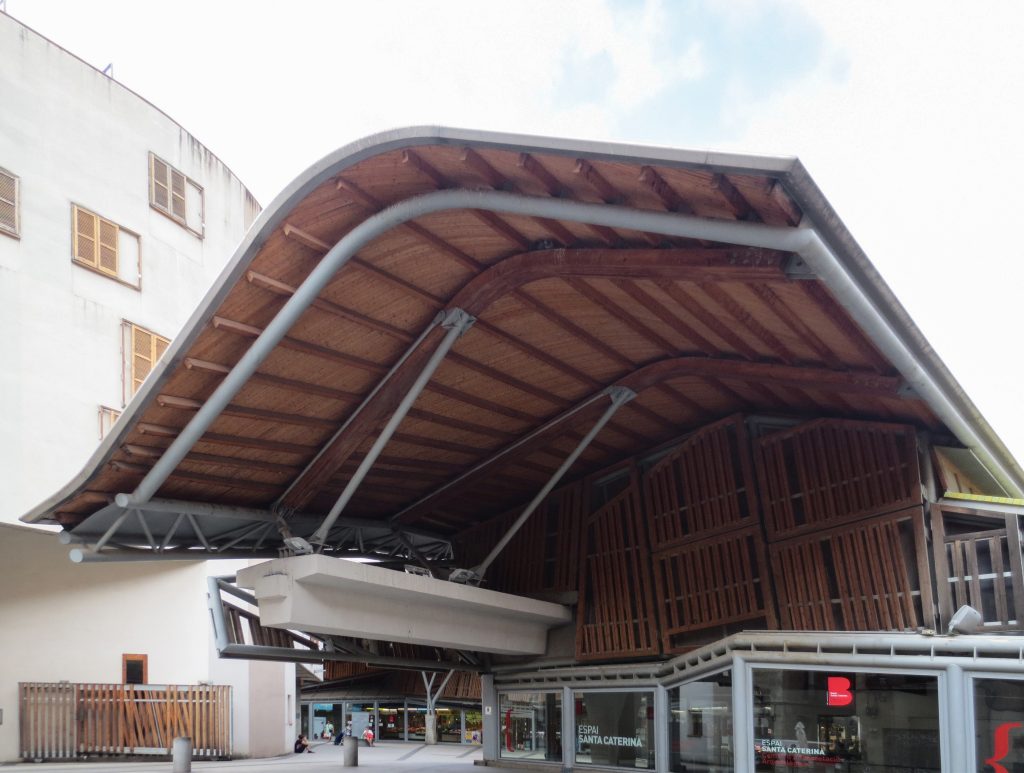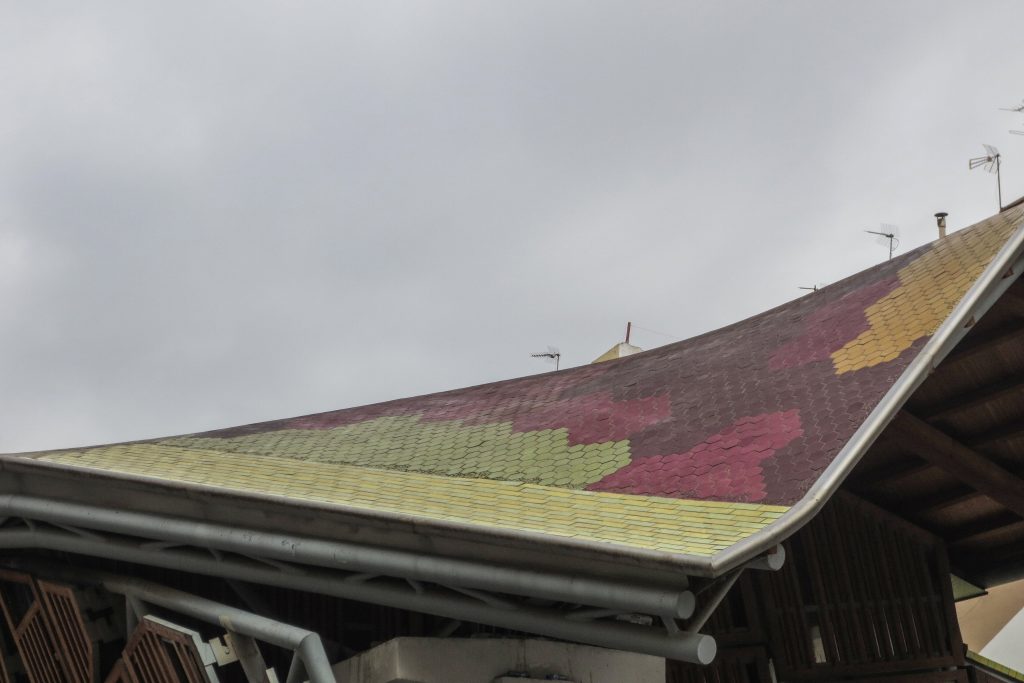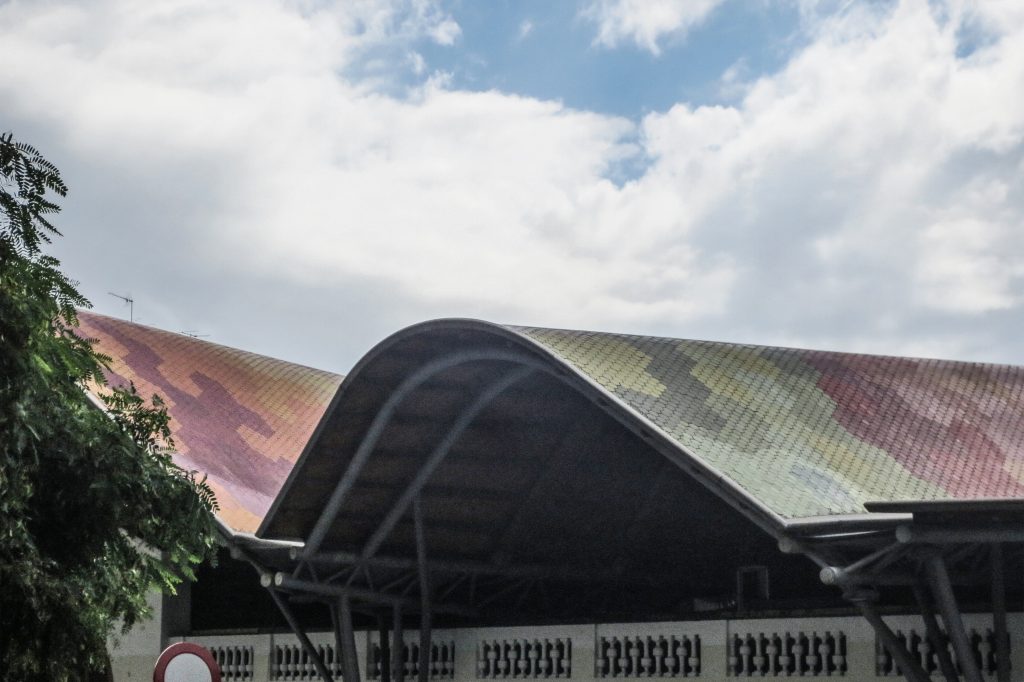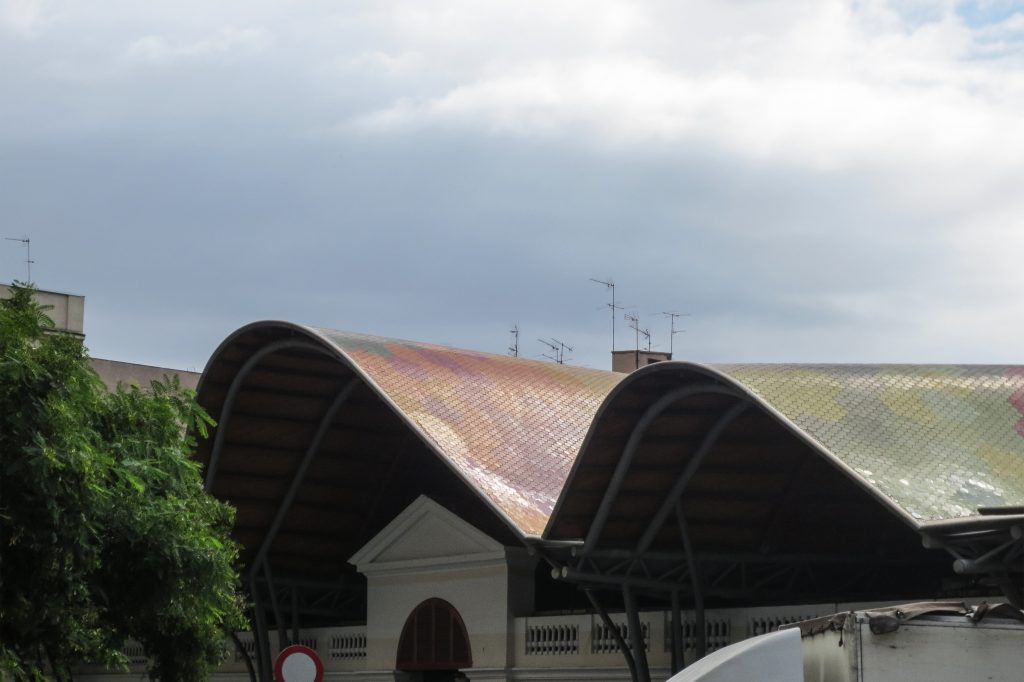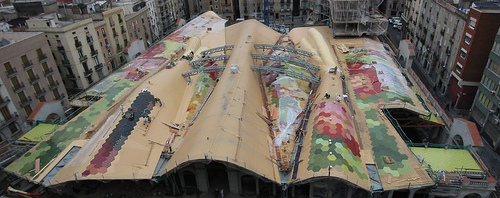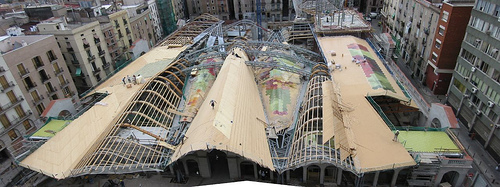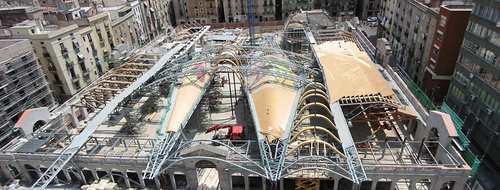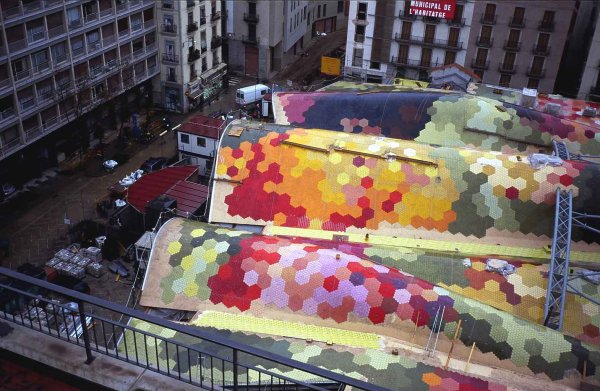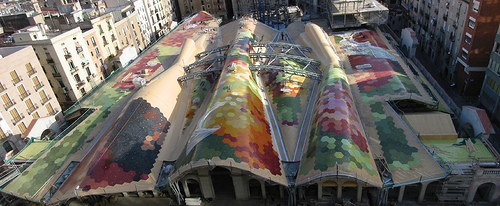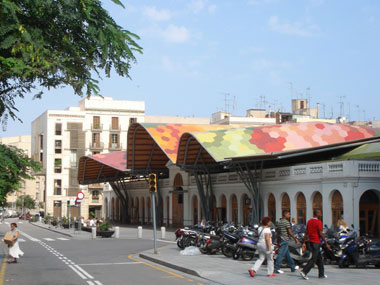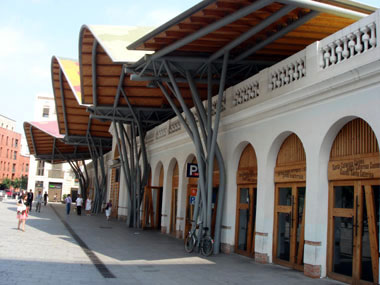Santa Catarina Market

Introduction
The architectural design is by Enric Miralles and Benedetta Tagliabue. The spectacular cover of colorful mosaics was designed by the artist Toni Comella. The engineer in charge of the roof structure was José María Velasco Rivas from the start of the project in 1997 until the completion of construction in 2005.
The market is part of the rehabilitation package made by the Barcelona Market Institute, which is dependent on the City Council. The proposal superimposes the new architecture on the old, the mixes, and arises with a conglomerate, a hybrid that accentuates utility and is contemporary. The internal distribution of the market was reorganized. There are fewer posts, but the access and service systems are rationalized, the surface of public spaces gains ground and communicates with the Avenue Francesc Cambó, an important transition vein in the neighborhood, also surrounded by a dense network of narrow streets.
The works of remodeling left exposed important architectural remains of the apse of the monastery, a space that can be visited. The old market preserves the entrance doors.
The architect Miralles died before finalizing the construction of the work.
History
Its history begins with the demolition of the convent of Santa Caterina, whose lands were granted to the city council of the city to raise the market. It was the architect, appointed by city council, Josep Mas Vila who presented the first project, an ambitious plan that far surpassed the functions of the existing markets in the Plaza del Born and in Sant Josep, where sales would be made to Wholesale, including the sale of meat. The project that would rise a few meters from the Cathedral of Barcelona and in the historic center of the city did not prosper since it was necessary to do so with the surrounding areas, not counting with the approval of the Madrid government.
In spite of the inconveniences in 1846 the market begins to work timidly and on a provisional basis, with a fishmonger and other few positions that had auctioned the city council to finance the works. In the post-war years the market supplied not only the citizens of the city but also those of the surrounding towns. This was the first covered market of the city, officially inaugurated in the year 1848.
Situation
The Santa Caterina Market is located in the district of Ciutat Vella and as well as the Basilica of Santa Maria del Mar in the district of the Rivera of Barcelona, Spain, on the avenue Francesc Cambó 16, forming part of the urban intervention of rehabilitation of the area.
Concept
The proposal for the rehabilitation of the old Santa Caterina Market, located in the Ciutat Vella district of Barcelona, involves action on the urban fabric adjacent to the existing structure that rationalizes its location. At the same time, the intervention intends to “blend and confuse” with the original structure. Both purposes are achieved by the realization of a new deck, which envelops the structure and extends it beyond the perimeter of the first construction.
The essence of this project is based on the design of its cover, which starts from the metaphor of an immense sea colored by the memory of fruits and vegetables. He also recovered elements already employed at the Hamburg Music School.
The work is spectacular and plays an important role in the urban recovery of Ciutat Vella (municipal project in which Miralles was actively involved).
The roof is transformed into the most important façade of the building, with the disadvantage that it is only visible from the height and, for now, there is no possibility of a viewpoint to contemplate it.
Spaces
The market has four entrances, the one of the main facade, others on the lateral streets and the one located in the square of the back part.
Floor
The project does not have an internal use approach, possibly because it wants to recover the structure of the old village markets, so that the cover would represent a large awning under which the posts are housed without any predetermined organization, although their corridors make up a private Irregular layout that facilitates access to them, located in the center of the plant. In the perimeter were located several shops that serve as support to the market offering products that are not in the stops inside, as well as bars and restaurants. The large deck hints at the generation of 3 naves, the central one being the highest one, approximately 40m
Parking
The market consists of 2 underground floors in which are located the parking and the space destined to garbage collection and dependencies to support the operation of the same.
Squares
In the back of the market two squares were created, one public that connects the market with the neighborhood and places one of the accesses and the other more private is obtained with the retranqueo gives the houses that were generated in the urbanization plan.
Structure
The market structure of Santa Caterina consists of a set of irregular wooden vaults, some triarticulate biarticulates, which are supported by steel beams of section and variable guideline, supported, in turn, in beams and concrete pillars. A set of three large arches with more than 40 meters of light centrally hold the triangulated steel beams to prevent their descent.
The central part does not retain any structure of the old market, in contrast the lateral aisles, with 14m of light, keep the old trunks, some have been repaired and others had to be replaced.
Cover
The structural study of the cover began at the end of 1997, and its process ends at the end of 1999, ending at the beginning of the year 2000. Enric Miralles saw all the construction plans before his death in July of 2000. During its construction only Introduced minor changes.
The structural solution of the cover emerged from an earlier process. The first approach of Miralles was a deck that floated on a sea of cables, at the same time wanted to recover traditional materials of the construction in Barcelona, the first one of all was the pottery that would cover the whole surface of the deck.
The structure of the roof consists mainly of wooden arches joined by metal beams type V that in some places are visible and in others hidden. The cover made with treated pine wood and an envigado sandwich of 2 layers of wood pine (wood of Flanders) machimbrado and other 2 of the same wood separated by slats of 4×4 with wool of rock following the form of the supporting arches and crossing them On a diagonal, is supported by two post-tensioned beams of 43x72m resting on two parallel pillars. Above these arches extends a splint that serves as the basis for the placement of the ceramic pieces of the cover.
The process for the structural calculation approach was complex. First, the type and thickness of the ceramic, as well as its form of application on the roof, were unknown. Traditionally the ceramic pieces, the “trencadís” Gaudino settled on about 2 cm of mortar. All this gave rise to an appreciable weight. Several types of pieces were designed and produced but at a given moment their evolution is paralyzed and the final solution is left for later, or for the moment of construction. Since the structural design was to be started, a maximum weight of 150 kg / m2 was considered, in the worst case, assuming a weight of 92 kg / m2 at the end. Of the 7,000m² of market area, 5,500 m² are covered by the spectacular roof.
Materials
From the original market have been preserved the lateral walls and the porticoed facade that had been reconstructed in 1988 and that delimit the plant of 100×70 m². The rest of the ship was basically built with wood, glass, metal and ceramics.
Woods
The forms for the pillars and exposed concrete beams were made with phenolic boards specially prepared for that purpose.
The woods of the deck structure were made with treated Flanders wood, in some cases in the form of boards and others in sandwich.
The inner enclosures were also made with wood of Flanders passed by autoclave and fastened to the metallic structure by means of angle welded to the same.
Ceramics
The emblematic cover of the market is made with 325,000 hexagonal pieces of 1m2 of glazed ceramic whose colors seek to reproduce the colors of the stands of fruits and vegetables. These pieces in turn are formed by 36 small hexagons. The ceramic pieces are enameled in 67 different colors.
Video
